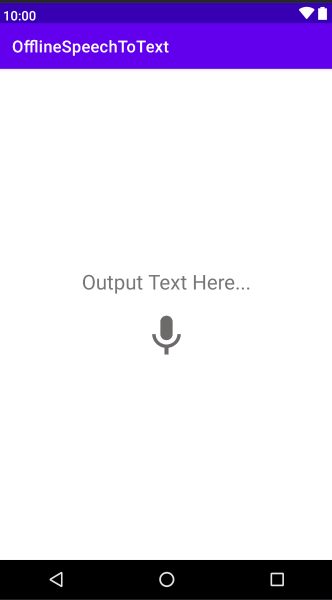在这种方法中,我们将在项目中实现脱机语音转文本功能。它可以在线和离线工作。如果没有互联网连接,它将使用我们的移动设备中预先存储的语言模型,因此无法清晰识别,但效果良好。在线时,它会正确识别所有单词。请注意,我们将使用Kotlin语言实施此项目。
Note: The offline method will not work on those devices whose API Version is less than 23.
分步实施
步骤1:创建一个新项目
要在Android Studio中创建新项目,请参阅如何在Android Studio中创建/启动新项目。请注意,选择Kotlin作为编程语言。
步骤2:添加权限
要访问移动设备麦克风,我们必须在AndroidManifest.xml文件中添加RECORD_AUDIO权限,如下所示:
步骤3:修改colors.xml文件
在colors.xml文件中添加以下行。
步骤4:使用activity_main.xml文件
转到activity_main.xml文件,并参考以下代码。以下是activity_main.xml文件的代码。
XML
Kotlin
private fun checkAudioPermission() {
if(Build.VERSION.SDK_INT >= Build.VERSION_CODES.M) { // M = 23
if(ContextCompat.checkSelfPermission(this, "android.permission.RECORD_AUDIO") != PackageManager.PERMISSION_GRANTED) {
// this will open settings which asks for permission
val intent = Intent(Settings.ACTION_APPLICATION_DETAILS_SETTINGS, Uri.parse("package:com.programmingtech.offlinespeechtotext"))
startActivity(intent)
Toast.makeText(this, "Allow Microphone Permission", Toast.LENGTH_SHORT).show()
}
}
}Kotlin
private fun startSpeechToText() {
val speechRecognizer = SpeechRecognizer.createSpeechRecognizer(this)
val speechRecognizerIntent = Intent(RecognizerIntent.ACTION_RECOGNIZE_SPEECH)
speechRecognizerIntent.putExtra(
RecognizerIntent.EXTRA_LANGUAGE_MODEL,
RecognizerIntent.LANGUAGE_MODEL_FREE_FORM
)
speechRecognizerIntent.putExtra(RecognizerIntent.EXTRA_LANGUAGE, Locale.getDefault())
speechRecognizer.setRecognitionListener(object : RecognitionListener {
override fun onReadyForSpeech(bundle: Bundle?) {}
override fun onBeginningOfSpeech() {}
override fun onRmsChanged(v: Float) {}
override fun onBufferReceived(bytes: ByteArray?) {}
override fun onEndOfSpeech() {}
override fun onError(i: Int) {}
override fun onResults(bundle: Bundle) {
val result = bundle.getStringArrayList(SpeechRecognizer.RESULTS_RECOGNITION)
if (result != null) {
// result[0] will give the output of speech
}
}
override fun onPartialResults(bundle: Bundle) {}
override fun onEvent(i: Int, bundle: Bundle?) {}
})
// starts listening ...
speechRecognizer.startListening(speechRecognizerIntent)
}Kotlin
import android.content.Intent
import android.content.pm.PackageManager
import android.net.Uri
import android.os.Build
import android.os.Bundle
import android.provider.Settings
import android.speech.RecognitionListener
import android.speech.RecognizerIntent
import android.speech.SpeechRecognizer
import android.widget.ImageView
import android.widget.TextView
import android.widget.Toast
import androidx.appcompat.app.AppCompatActivity
import androidx.core.content.ContextCompat
import java.util.*
class MainActivity : AppCompatActivity() {
private lateinit var micIV: ImageView
private lateinit var outputTV: TextView
override fun onCreate(savedInstanceState: Bundle?) {
super.onCreate(savedInstanceState)
setContentView(R.layout.activity_main)
micIV = findViewById(R.id.mic_speak_iv)
outputTV = findViewById(R.id.speak_output_tv)
micIV.setOnClickListener {
checkAudioPermission()
// changing the color of mic icon, which
// indicates that it is currently listening
micIV.setColorFilter(ContextCompat.getColor(this, R.color.mic_enabled_color)) // #FF0E87E7
startSpeechToText()
}
}
private fun startSpeechToText() {
val speechRecognizer = SpeechRecognizer.createSpeechRecognizer(this)
val speechRecognizerIntent = Intent(RecognizerIntent.ACTION_RECOGNIZE_SPEECH)
speechRecognizerIntent.putExtra(
RecognizerIntent.EXTRA_LANGUAGE_MODEL,
RecognizerIntent.LANGUAGE_MODEL_FREE_FORM
)
speechRecognizerIntent.putExtra(RecognizerIntent.EXTRA_LANGUAGE, Locale.getDefault())
speechRecognizer.setRecognitionListener(object : RecognitionListener {
override fun onReadyForSpeech(bundle: Bundle?) {}
override fun onBeginningOfSpeech() {}
override fun onRmsChanged(v: Float) {}
override fun onBufferReceived(bytes: ByteArray?) {}
override fun onEndOfSpeech() {
// changing the color of our mic icon to
// gray to indicate it is not listening
micIV.setColorFilter(ContextCompat.getColor(applicationContext, R.color.mic_disabled_color)) // #FF6D6A6A
}
override fun onError(i: Int) {}
override fun onResults(bundle: Bundle) {
val result = bundle.getStringArrayList(SpeechRecognizer.RESULTS_RECOGNITION)
if (result != null) {
// attaching the output
// to our textview
outputTV.text = result[0]
}
}
override fun onPartialResults(bundle: Bundle) {}
override fun onEvent(i: Int, bundle: Bundle?) {}
})
speechRecognizer.startListening(speechRecognizerIntent)
}
private fun checkAudioPermission() {
if (Build.VERSION.SDK_INT >= Build.VERSION_CODES.M) { // M = 23
if (ContextCompat.checkSelfPermission(this, "android.permission.RECORD_AUDIO") != PackageManager.PERMISSION_GRANTED) {
val intent = Intent(Settings.ACTION_APPLICATION_DETAILS_SETTINGS, Uri.parse("package:com.programmingtech.offlinespeechtotext"))
startActivity(intent)
Toast.makeText(this, "Allow Microphone Permission", Toast.LENGTH_SHORT).show()
}
}
}
}输出界面:

步骤5:使用MainActivity.kt文件
转到MainActivity.kt文件,并参考以下代码。
检查音频权限:
首先,我们首先需要允许该应用访问麦克风权限。此函数将检查该应用程序是否能够访问麦克风权限。如果未授予该权限,则它将直接打开设置,用户可以从那里手动允许麦克风权限。较低的API版本(例如23以下)不支持此离线语音转文本功能,因此在这里,我们首先使用Build.VERSION.SDK_INT检查移动API版本,在这里Build.VERSION_CODES.M将返回M的常量值,23.用您的程序包名称替换代码中的程序包名称(您可以从AndroidManifest.xml文件中找到您的程序包名称)
科特林
private fun checkAudioPermission() {
if(Build.VERSION.SDK_INT >= Build.VERSION_CODES.M) { // M = 23
if(ContextCompat.checkSelfPermission(this, "android.permission.RECORD_AUDIO") != PackageManager.PERMISSION_GRANTED) {
// this will open settings which asks for permission
val intent = Intent(Settings.ACTION_APPLICATION_DETAILS_SETTINGS, Uri.parse("package:com.programmingtech.offlinespeechtotext"))
startActivity(intent)
Toast.makeText(this, "Allow Microphone Permission", Toast.LENGTH_SHORT).show()
}
}
}
处理语音到文本的函数:
这是我们处理语音的项目的主要函数。我们必须首先创建当前Context的SpeechRecognizer类的对象,即此对象(如果我们正在使用任何Fragments,AlertDialog等,则可以用context代替它)。然后,我们必须创建一个意图并将EXTRA_LANGUAGE_MODEL和LANGUAGE_MODEL_FREE_FORM附加到该意图。在setRecognitionListener()方法中,我们必须重写所有必需的函数,如下所示。要获得语音结果,我们必须使用onResults()方法并存储Bundle中输出的数组列表。第一个索引处的元素将提供语音输出。我们还可以使用有用的函数,例如onBeginningOfSpeech()在开始监听之前首先运行,以及onEndOfSpeech()在结果之后运行。
科特林
private fun startSpeechToText() {
val speechRecognizer = SpeechRecognizer.createSpeechRecognizer(this)
val speechRecognizerIntent = Intent(RecognizerIntent.ACTION_RECOGNIZE_SPEECH)
speechRecognizerIntent.putExtra(
RecognizerIntent.EXTRA_LANGUAGE_MODEL,
RecognizerIntent.LANGUAGE_MODEL_FREE_FORM
)
speechRecognizerIntent.putExtra(RecognizerIntent.EXTRA_LANGUAGE, Locale.getDefault())
speechRecognizer.setRecognitionListener(object : RecognitionListener {
override fun onReadyForSpeech(bundle: Bundle?) {}
override fun onBeginningOfSpeech() {}
override fun onRmsChanged(v: Float) {}
override fun onBufferReceived(bytes: ByteArray?) {}
override fun onEndOfSpeech() {}
override fun onError(i: Int) {}
override fun onResults(bundle: Bundle) {
val result = bundle.getStringArrayList(SpeechRecognizer.RESULTS_RECOGNITION)
if (result != null) {
// result[0] will give the output of speech
}
}
override fun onPartialResults(bundle: Bundle) {}
override fun onEvent(i: Int, bundle: Bundle?) {}
})
// starts listening ...
speechRecognizer.startListening(speechRecognizerIntent)
}
下面是MainActivity.kt文件的最终代码。在代码内部添加了注释,以更详细地了解代码。
科特林
import android.content.Intent
import android.content.pm.PackageManager
import android.net.Uri
import android.os.Build
import android.os.Bundle
import android.provider.Settings
import android.speech.RecognitionListener
import android.speech.RecognizerIntent
import android.speech.SpeechRecognizer
import android.widget.ImageView
import android.widget.TextView
import android.widget.Toast
import androidx.appcompat.app.AppCompatActivity
import androidx.core.content.ContextCompat
import java.util.*
class MainActivity : AppCompatActivity() {
private lateinit var micIV: ImageView
private lateinit var outputTV: TextView
override fun onCreate(savedInstanceState: Bundle?) {
super.onCreate(savedInstanceState)
setContentView(R.layout.activity_main)
micIV = findViewById(R.id.mic_speak_iv)
outputTV = findViewById(R.id.speak_output_tv)
micIV.setOnClickListener {
checkAudioPermission()
// changing the color of mic icon, which
// indicates that it is currently listening
micIV.setColorFilter(ContextCompat.getColor(this, R.color.mic_enabled_color)) // #FF0E87E7
startSpeechToText()
}
}
private fun startSpeechToText() {
val speechRecognizer = SpeechRecognizer.createSpeechRecognizer(this)
val speechRecognizerIntent = Intent(RecognizerIntent.ACTION_RECOGNIZE_SPEECH)
speechRecognizerIntent.putExtra(
RecognizerIntent.EXTRA_LANGUAGE_MODEL,
RecognizerIntent.LANGUAGE_MODEL_FREE_FORM
)
speechRecognizerIntent.putExtra(RecognizerIntent.EXTRA_LANGUAGE, Locale.getDefault())
speechRecognizer.setRecognitionListener(object : RecognitionListener {
override fun onReadyForSpeech(bundle: Bundle?) {}
override fun onBeginningOfSpeech() {}
override fun onRmsChanged(v: Float) {}
override fun onBufferReceived(bytes: ByteArray?) {}
override fun onEndOfSpeech() {
// changing the color of our mic icon to
// gray to indicate it is not listening
micIV.setColorFilter(ContextCompat.getColor(applicationContext, R.color.mic_disabled_color)) // #FF6D6A6A
}
override fun onError(i: Int) {}
override fun onResults(bundle: Bundle) {
val result = bundle.getStringArrayList(SpeechRecognizer.RESULTS_RECOGNITION)
if (result != null) {
// attaching the output
// to our textview
outputTV.text = result[0]
}
}
override fun onPartialResults(bundle: Bundle) {}
override fun onEvent(i: Int, bundle: Bundle?) {}
})
speechRecognizer.startListening(speechRecognizerIntent)
}
private fun checkAudioPermission() {
if (Build.VERSION.SDK_INT >= Build.VERSION_CODES.M) { // M = 23
if (ContextCompat.checkSelfPermission(this, "android.permission.RECORD_AUDIO") != PackageManager.PERMISSION_GRANTED) {
val intent = Intent(Settings.ACTION_APPLICATION_DETAILS_SETTINGS, Uri.parse("package:com.programmingtech.offlinespeechtotext"))
startActivity(intent)
Toast.makeText(this, "Allow Microphone Permission", Toast.LENGTH_SHORT).show()
}
}
}
}